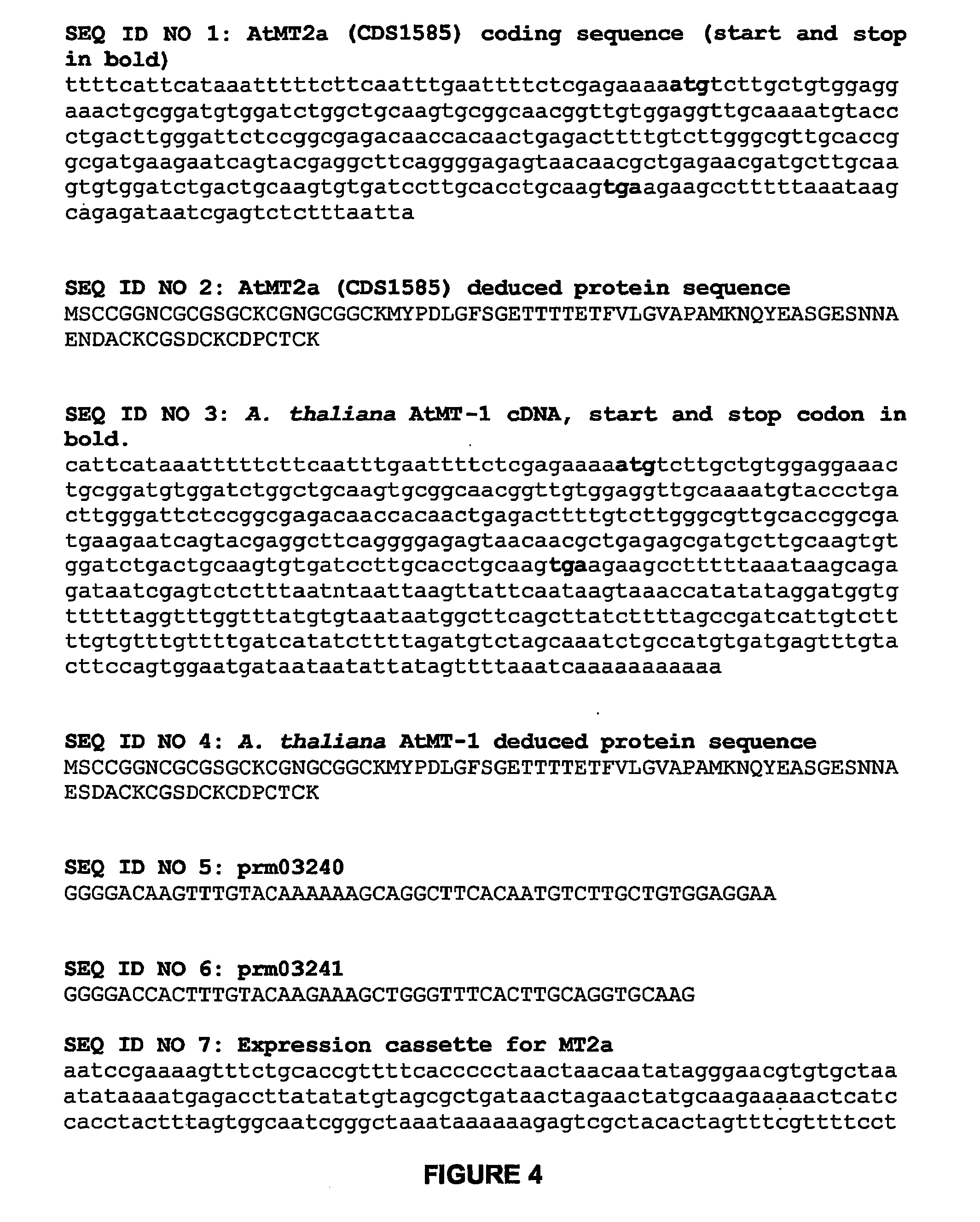Plants having modified growth characteristics and method for making the same
a technology of growth characteristics and plants, applied in the field of methods for modifying plant growth characteristics, can solve problems such as toxic to living cells
- Summary
- Abstract
- Description
- Claims
- Application Information
AI Technical Summary
Benefits of technology
Problems solved by technology
Method used
Image
Examples
example 1
Cloning of CDS0851
[0112] The Arabidopsis metallothionein coding sequence AtMT2a (CDS1585) was amplified by PCR using as template an Arabidopsis thaliana seedling cDNA library (Invitrogen, Paisley, UK). After reverse transcription of RNA extracted from seedlings, the cDNAs were cloned into pCMV Sport 6.0. Average insert size of the bank was 1.5 kb, and original number of clones was of 1.59×107 cfu. The original titer was determined to be 9.6×105 cfu / ml, and after a first amplification became 6×1011 cfu / ml. After plasmid extraction, 200 ng of template was used in a 50 μl PCR mix. Primers prm03240 (SEQ ID NO 5) and prm03241 (SEQ ID NO 6), which include the AttB sites for Gateway recombination, were used for PCR amplification. PCR was performed using Hifi Taq DNA polymerase in standard conditions. A PCR fragment of 246 bp was amplified and purified also using standard methods. The first step of the Gateway procedure, the BP reaction, was then performed, during which the PCR fragment re...
example 2
Vector Construction for Transformation with PRO0129-CDS1585 Cassette
[0113] The entry clone p33 was subsequently used in an LR reaction with p0640, a destination vector used for Oryza sativa transformation. This vector contains as functional elements within the T-DNA borders: a plant selectable marker; a screenable marker expression cassette; and a Gateway cassette intended for LR in vivo recombination with the sequence of interest already cloned in the entry done. A rice GOS2 promoter for constitutive expression (PRO0129) is located upstream of this Gateway cassette.
[0114] After the LR recombination step, the resulting expression vector p34 (FIG. 2) can be transformed into the Agrobacerium strain LBA4044 and subsequently to Oryza saliva plants.
example 3
Transformation of Rice with PRO0129-CDS1585
[0115] Mature dry seeds of Oryza saliva japonica cultivar Nipponbare were dehusked. Sterilization was done by incubating the seeds for one minute in 70% ethanol, followed by 30 minutes in 0.2% HgCl2 and by 6 washes of 15 minutes with sterile distilled water. The sterile seeds were then germinated on a medium containing 2,4-D (callus induction medium). After a 4-week incubation in the dark, embryogenic, scutellum-derived calli were excised and propagated on the same medium. Two weeks later, the calli were multiplied or propagated by subculture on the same medium for another 2 weeks. 3 days before co-cultivation, embryogenic callus pieces were sub-cultured on fresh medium to boost cell division activity. The Agrobacterium strain LBA4044 harbouring the binary vector p3076 was used for co-cultivation. The Agrobacterium strain was cultured for 3 days at 28° C. on AB medium with the appropriate antibiotics. The bacteria were then collected and s...
PUM
| Property | Measurement | Unit |
|---|---|---|
| Weight | aaaaa | aaaaa |
| Electrical resistance | aaaaa | aaaaa |
Abstract
Description
Claims
Application Information
 Login to View More
Login to View More - R&D
- Intellectual Property
- Life Sciences
- Materials
- Tech Scout
- Unparalleled Data Quality
- Higher Quality Content
- 60% Fewer Hallucinations
Browse by: Latest US Patents, China's latest patents, Technical Efficacy Thesaurus, Application Domain, Technology Topic, Popular Technical Reports.
© 2025 PatSnap. All rights reserved.Legal|Privacy policy|Modern Slavery Act Transparency Statement|Sitemap|About US| Contact US: help@patsnap.com



